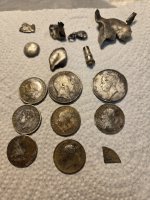Gypsy Heart
Gold Member
While the site was used as a camping ground during the Spanish and Mexican periods, who called it Santa Teresa, it was during the early American occupation of the area that Maricopa Wells was one of the most important stops on the southwestern trail between Texas and the Pacific Ocean. With the coming of the stagelines, starting in 1857, the Wells, as it was known was one of the most important trading and supply stations in Arizona and certainly central point of to which most trails converged. Any traveller going though the southern and central regions of territorial Arizona, whether north-south or east-west, would certainly stop, rest and resupply. Though the Wells came explorers, mountain men, soldiers, mule trails carrying cargo, stagecoaches, the mail deliveries and the telegraph lines. All early Arizona pioneers stopped here on their way to destiny. Through here also passed the Oatman family with daughter Olivia, on her way to tragedy and unwanted fame near Gila Bend, as the most famous white Indian captive in American history.
When standing in the open filed, surrounded by a few shrubs and shallow holes, it is hard to imagine the beehive of activity described as follows in the journal of E. O. Stratton:
"Though small, Maricopa Wells was a busy place. The stages passing twice a day, one eastbound and one westbound, changed animals and fed their passengers here. When troops were discharged - and this was often - the stages were full both ways. At other times there was a predominance of passengers from the west. Not only were many Californians coming into the country, but there also were the Easterners who had gone by train or around the Horn to San Francisco, then came down the coast to San Diego and into Arizona by stage. Then, too, Maricopa Wells was the division point for Phoenix, Fort McDowell on the Verde, and other places to the north. The camping ground outside the enclosure was also a busy place. Great freight trains of three or four wagons and eight to twenty mules were often camped there; and detachments of soldiers - from a few scouts to one or more companies - might turn in for the night. Soldiers scouting through the immediate country usually made Maricopa Wells their supply station; and all westbound traffic, whether or not they camped, had to load up with enough water to last across the desert from Maricopa to Gila Bend, a distance of forty-five miles which meant at least one night's camp."
By 1870, when Maricopa Wells station was purchased by well-known pioneers James A Moore and Larkin Carr, it had become what may be called Arizona's first mini-mall, with a general store, saloon, staff living quarters, an office, a blacksmith shop, stables, and a hotel, all in one long "U" shaped building surrounding a two acre square enclosed by a high abode wall on the open end. The Wells, famous for its hospitality and fine kitchen fair, was probably the only place between Texas and California where a good hot meal was served to the traveller, often with live music provided by Moore's twin daughters.
By the middle of the 19th century, traffic on the trail was intense. In the three years following the discovery of gold in California, more than 60,000 people crossed the ferry at Yuma, almost all of these passing through Maricopa. The diary of George Evans, a Forty-Niner, mentions at least seven companies camped at or passing through the Pima villages in the two days he was there.
. One of the few pictures of the old station. This was a major post on trail to California when Phoenix was still Pumkinville.
http://www.brazilbrazil.com/maricopa.html
When standing in the open filed, surrounded by a few shrubs and shallow holes, it is hard to imagine the beehive of activity described as follows in the journal of E. O. Stratton:
"Though small, Maricopa Wells was a busy place. The stages passing twice a day, one eastbound and one westbound, changed animals and fed their passengers here. When troops were discharged - and this was often - the stages were full both ways. At other times there was a predominance of passengers from the west. Not only were many Californians coming into the country, but there also were the Easterners who had gone by train or around the Horn to San Francisco, then came down the coast to San Diego and into Arizona by stage. Then, too, Maricopa Wells was the division point for Phoenix, Fort McDowell on the Verde, and other places to the north. The camping ground outside the enclosure was also a busy place. Great freight trains of three or four wagons and eight to twenty mules were often camped there; and detachments of soldiers - from a few scouts to one or more companies - might turn in for the night. Soldiers scouting through the immediate country usually made Maricopa Wells their supply station; and all westbound traffic, whether or not they camped, had to load up with enough water to last across the desert from Maricopa to Gila Bend, a distance of forty-five miles which meant at least one night's camp."
By 1870, when Maricopa Wells station was purchased by well-known pioneers James A Moore and Larkin Carr, it had become what may be called Arizona's first mini-mall, with a general store, saloon, staff living quarters, an office, a blacksmith shop, stables, and a hotel, all in one long "U" shaped building surrounding a two acre square enclosed by a high abode wall on the open end. The Wells, famous for its hospitality and fine kitchen fair, was probably the only place between Texas and California where a good hot meal was served to the traveller, often with live music provided by Moore's twin daughters.
By the middle of the 19th century, traffic on the trail was intense. In the three years following the discovery of gold in California, more than 60,000 people crossed the ferry at Yuma, almost all of these passing through Maricopa. The diary of George Evans, a Forty-Niner, mentions at least seven companies camped at or passing through the Pima villages in the two days he was there.
. One of the few pictures of the old station. This was a major post on trail to California when Phoenix was still Pumkinville.
http://www.brazilbrazil.com/maricopa.html






